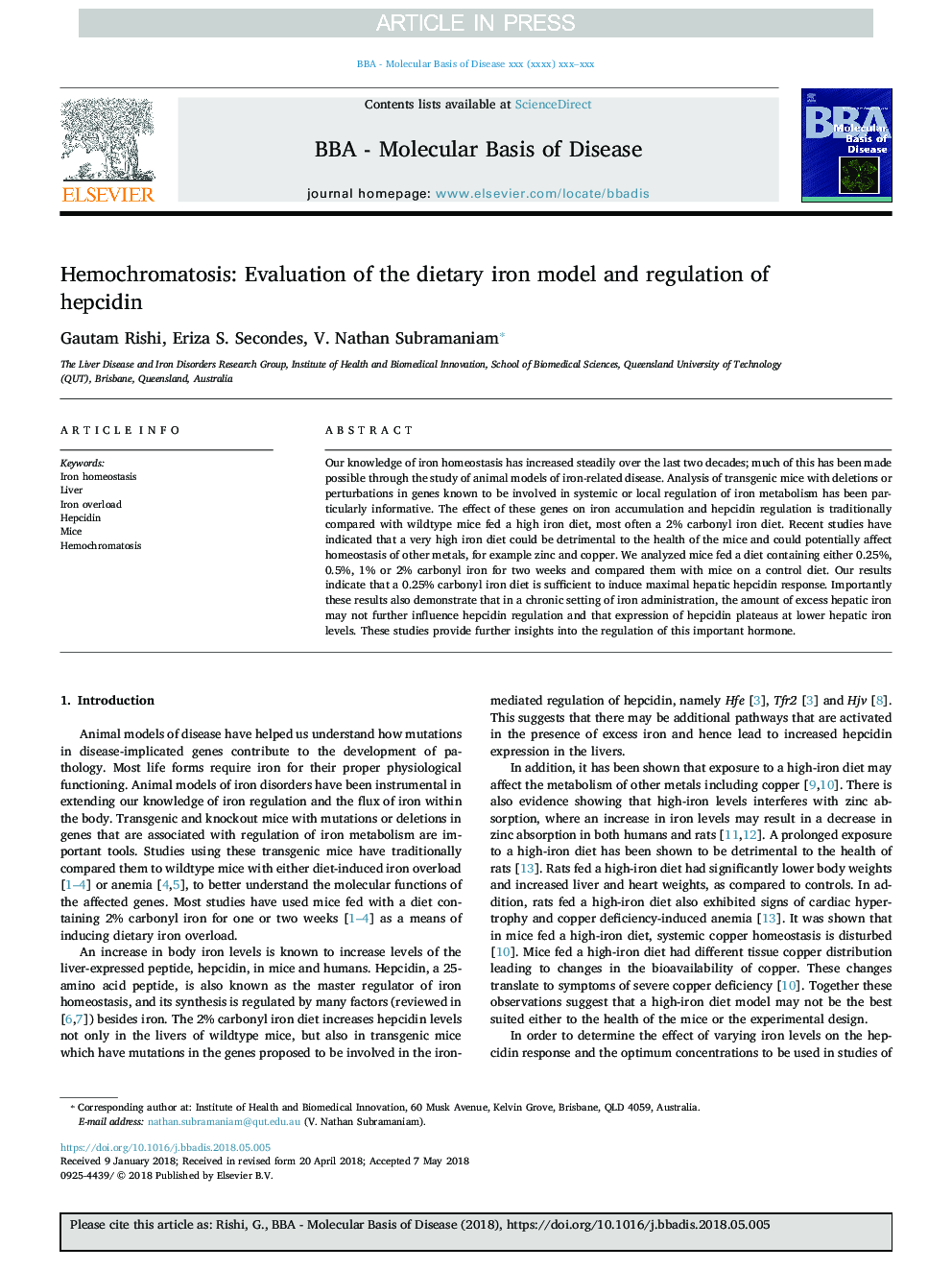| کد مقاله | کد نشریه | سال انتشار | مقاله انگلیسی | نسخه تمام متن |
|---|---|---|---|---|
| 8258377 | 1534603 | 2018 | 7 صفحه PDF | دانلود رایگان |
عنوان انگلیسی مقاله ISI
Hemochromatosis: Evaluation of the dietary iron model and regulation of hepcidin
ترجمه فارسی عنوان
هموکروماتوز: ارزیابی مدل آهن رژیم غذایی و تنظیم هپسیدین
دانلود مقاله + سفارش ترجمه
دانلود مقاله ISI انگلیسی
رایگان برای ایرانیان
کلمات کلیدی
هومئوستاز آهن کبد، بیش از حد آهن، هپسیدین، موش، هموکروماتوز،
ترجمه چکیده
دانش ما در مورد هوموستاز آهن در دو دهه گذشته به طور پیوسته افزایش یافته است؛ بسیاری از این موارد از طریق مطالعه مدل های حیوانی بیماری های مرتبط با آهن امکان پذیر است. تجزیه و تحلیل موش های ترانس ژنیک با حذف و یا اختلال در ژن هایی که شناخته شده اند در تنظیمات سیستماتیک و یا محلی متابولیسم آهن است، به ویژه اطلاعاتی است. تأثیر این ژن ها بر تجمع آهن و تنظیم هپسیدین به طور سنتی با موش های ویتیپ با رژیم غذایی با آهن بالا، اغلب 2٪ رژیم کربونیل آهن است. مطالعات اخیر نشان داده اند که یک رژیم غذایی بسیار زیاد آهن می تواند برای سلامتی موش ها زیان آور باشد و به طور بالقوه می تواند هوموتازیست های دیگر فلزات مانند روی و مس را تحت تاثیر قرار دهد. ما موش هایی که رژیم غذایی حاوی 0.25٪، 0.5٪، 1٪ یا 2٪ کربونیل آهن را برای دو هفته تغذیه کردند و آنها را با رژیم غذایی کنترل کردیم. نتایج ما نشان می دهد که یک رژیم غذایی کربونیل 0.25٪ کافی برای ایجاد حداکثر پاسخ هپسیدین کبدی کافی است. مهم این نتایج همچنین نشان می دهد که در حالت مزمن کنترل آهن، مقدار آهن کبدی بیش از حد ممکن است بر تنظیم هپسیدین و بیان پلاک هپسیدین در سطوح پایین کبد آهن تاثیر بگذارد. این مطالعات بینش بیشتری را درباره تنظیم این هورمون مهم ارائه می دهد.
موضوعات مرتبط
علوم زیستی و بیوفناوری
بیوشیمی، ژنتیک و زیست شناسی مولکولی
سالمندی
چکیده انگلیسی
Our knowledge of iron homeostasis has increased steadily over the last two decades; much of this has been made possible through the study of animal models of iron-related disease. Analysis of transgenic mice with deletions or perturbations in genes known to be involved in systemic or local regulation of iron metabolism has been particularly informative. The effect of these genes on iron accumulation and hepcidin regulation is traditionally compared with wildtype mice fed a high iron diet, most often a 2% carbonyl iron diet. Recent studies have indicated that a very high iron diet could be detrimental to the health of the mice and could potentially affect homeostasis of other metals, for example zinc and copper. We analyzed mice fed a diet containing either 0.25%, 0.5%, 1% or 2% carbonyl iron for two weeks and compared them with mice on a control diet. Our results indicate that a 0.25% carbonyl iron diet is sufficient to induce maximal hepatic hepcidin response. Importantly these results also demonstrate that in a chronic setting of iron administration, the amount of excess hepatic iron may not further influence hepcidin regulation and that expression of hepcidin plateaus at lower hepatic iron levels. These studies provide further insights into the regulation of this important hormone.
ناشر
Database: Elsevier - ScienceDirect (ساینس دایرکت)
Journal: Biochimica et Biophysica Acta (BBA) - Molecular Basis of Disease - Volume 1864, Issue 8, August 2018, Pages 2550-2556
Journal: Biochimica et Biophysica Acta (BBA) - Molecular Basis of Disease - Volume 1864, Issue 8, August 2018, Pages 2550-2556
نویسندگان
Gautam Rishi, Eriza S. Secondes, V. Nathan Subramaniam,
